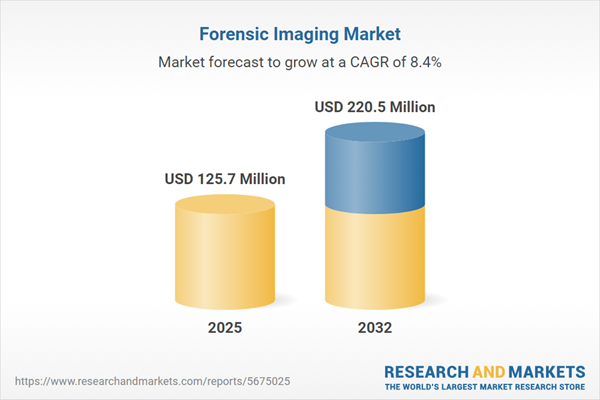Speak directly to the analyst to clarify any post sales queries you may have.
The forensic imaging market is rapidly evolving, driven by increasing demands for advanced, precise evidence analysis in modern investigations. Senior decision-makers are navigating a landscape defined by innovation, regulatory scrutiny, and growing operational complexity, requiring both strategic agility and investment foresight.
Market Snapshot: Growth Trajectory and Industry Dynamics
The forensic imaging market grew from USD 115.88 million in 2024 to USD 125.70 million in 2025. Sustained by a compound annual growth rate (CAGR) of 8.37%, the market is anticipated to reach USD 220.50 million by 2032. This growth is underpinned by judicial demands for higher evidence integrity, next-generation imaging technologies, and the global push toward streamlined case resolution and legal compliance. The primary keyword "forensic imaging market" encapsulates the shifting competitive and operational environment shaping current investment priorities for industry leaders.
Scope & Segmentation of the Forensic Imaging Market
This report delivers in-depth analysis across core segmentation criteria to inform granular market strategy decisions. Coverage includes:
- Technologies: 3D laser scanning, computed tomography, infrared imaging, photogrammetry, ultrasound imaging, and X ray imaging are advancing analytical accuracy and field applications.
- Applications: Crime scene reconstruction, document examination, facial reconstruction, tool mark analysis, and wound pattern analysis are expanding the use cases and driving the evolution of forensic best practices.
- Components: The market covers key hardware such as 3D scanners, accessories, imaging cameras, and workstations, complemented by a robust suite of services (consulting, maintenance, support, training) and software solutions (database management, image analysis, visualization).
- End Users: Forensic laboratories, law enforcement agencies, private investigation firms, research institutions, and security services represent diverse operational settings leveraging tailored imaging modalities.
- Deployment Modes: Cloud-based platforms and on-premise configurations support compliance, collaboration, and secure data management across organizations of varying scale and jurisdiction.
- Regions: Americas (including North America and Latin America), Europe, Middle East & Africa (EMEA), and Asia-Pacific, each with distinct regulatory frameworks, infrastructural maturity, and adoption patterns.
Key Takeaways for Senior Decision-Makers
- Cutting-edge sensor technologies and analytical tools are elevating reliability in evidence capture and interpretation, shortening investigation timelines and supporting courtroom admissibility.
- Integrated, cloud-based and on-premise solutions are fostering multi-jurisdictional data sharing, balancing quick access with essential control over sensitive evidence.
- Rising regulatory expectations surrounding data integrity and privacy are prompting organizations to enhance compliance mechanisms and invest in fortified digital workflows.
- Collaboration between forensic laboratories, technology providers, and research entities is accelerating the transformation of innovation pipelines into practical, deployable solutions.
- Diversity in technology adoption is enabling more tailored, scenario-specific deployment, while advancements in portability and real-time scene analysis are improving field investigation responsiveness.
Tariff Impact: Navigating Cost Pressures and Supply Chain Resilience
The United States imposed new tariffs in 2025 on specialized forensic imaging hardware, prompting global manufacturers to reevaluate sourcing and distribution strategies. Upstream cost increases led to revised contract terms, adoption of dual sourcing, and an intensified push for regional manufacturing that supports continuity of supply. Service pricing models are evolving, with agencies rebalancing equipment investment and vendor collaboration. Strategic procurement planning and diversified partnerships have become vital for mitigating tariff-driven disruptions and sustaining operational effectiveness across the supply chain.
Methodology & Data Sources
This analysis synthesizes primary research, including in-depth expert interviews and structured user surveys, with secondary research from white papers, regulatory documents, and scholarly literature. Data triangulation and peer review ensure accuracy and actionable insight, while proprietary databases support comprehensive segmentation and trend identification.
Why This Report Matters to Decision-Makers
- Enables executive teams to benchmark technology investments against global best practices, aligning capabilities with fast-evolving regulatory and operational demands.
- Delivers a nuanced segmentation of end users, applications, and components, informing targeted product development and market expansion strategies.
- Provides actionable guidance for resilience through procurement diversification and collaborative partnerships, supporting risk mitigation as market volatility and compliance pressures intensify.
Conclusion: Strategic Outlook for the Forensic Imaging Market
The forensic imaging market will continue to be shaped by technological innovation, heightened compliance imperatives, and adaptive supply chain strategies. Firms that prioritize modular design, collaborative research, and continuous upskilling will be well-positioned to lead in the next era of forensic evidence analysis.
Additional Product Information:
- Purchase of this report includes 1 year online access with quarterly updates.
- This report can be updated on request. Please contact our Customer Experience team using the Ask a Question widget on our website.
Table of Contents
3. Executive Summary
4. Market Overview
7. Cumulative Impact of Artificial Intelligence 2025
Companies Mentioned
The companies profiled in this Forensic Imaging market report include:- Thermo Fisher Scientific Inc.
- Agilent Technologies, Inc.
- Bruker Corporation
- Shimadzu Corporation
- PerkinElmer, Inc.
- Waters Corporation
- Danaher Corporation
- FARO Technologies, Inc.
- Hexagon AB
- Leica Microsystems GmbH
Table Information
| Report Attribute | Details |
|---|---|
| No. of Pages | 197 |
| Published | October 2025 |
| Forecast Period | 2025 - 2032 |
| Estimated Market Value ( USD | $ 125.7 Million |
| Forecasted Market Value ( USD | $ 220.5 Million |
| Compound Annual Growth Rate | 8.3% |
| Regions Covered | Global |
| No. of Companies Mentioned | 11 |









